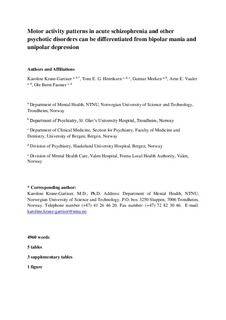| dc.contributor.author | Krane-Gartiser, Karoline | |
| dc.contributor.author | Henriksen, Tone Elise Gjøtterud | |
| dc.contributor.author | Morken, Gunnar | |
| dc.contributor.author | Vaaler, Arne | |
| dc.contributor.author | Fasmer, Ole Bernt | |
| dc.date.accessioned | 2019-02-14T12:53:38Z | |
| dc.date.available | 2019-02-14T12:53:38Z | |
| dc.date.created | 2018-10-25T12:25:50Z | |
| dc.date.issued | 2018 | |
| dc.identifier.citation | Psychiatry Research. 2018, 270 418-425. | nb_NO |
| dc.identifier.issn | 0165-1781 | |
| dc.identifier.uri | http://hdl.handle.net/11250/2585473 | |
| dc.description.abstract | The purpose of this study was to compare 24-h motor activity patterns between and within three groups of acutely admitted inpatients with schizophrenia and psychotic disorders (n = 28), bipolar mania (n = 18) and motor-retarded unipolar depression (n = 25) and one group of non-hospitalized healthy individuals (n = 28). Motor activity was measured by wrist actigraphy, and analytical approaches using linear and non-linear variability and irregularity measures were undertaken. In between-group comparisons, the schizophrenia group showed more irregular activity patterns than depression cases and healthy individuals. The schizophrenia and mania cases were clinically similar with respect to high prevalence of psychotic symptoms. Although they could not be separated by a formal statistical test, the schizophrenia cases showed more normal amplitudes in morning to evening mean activity and activity variability. Schizophrenia constituted an independent entity in terms of motor activation that could be distinguished from the other diagnostic groups of psychotic and non-psychotic affective disorders. Despite limitations such as small subgroups, short recordings and confounding effects of medication/hospitalization, these results suggest that detailed temporal analysis of motor activity patterns can identify similarities and differences between prevalent functional psychiatric disorders. For this purpose, irregularity measures seem particularly useful to characterize psychotic symptoms and should be explored in larger samples with longer-term recordings, while searching for underlying mechanisms of motor activity disturbances. | nb_NO |
| dc.language.iso | eng | nb_NO |
| dc.publisher | Elsevier | nb_NO |
| dc.rights | Attribution-NonCommercial-NoDerivatives 4.0 Internasjonal | * |
| dc.rights.uri | http://creativecommons.org/licenses/by-nc-nd/4.0/deed.no | * |
| dc.title | Motor activity patterns in acute schizophrenia and other psychotic disorders can be differentiated from bipolar mania and unipolar depression | nb_NO |
| dc.title.alternative | Motor activity patterns in acute schizophrenia and other psychotic disorders can be differentiated from bipolar mania and unipolar depression | nb_NO |
| dc.type | Journal article | nb_NO |
| dc.type | Peer reviewed | nb_NO |
| dc.description.version | acceptedVersion | nb_NO |
| dc.source.pagenumber | 418-425 | nb_NO |
| dc.source.volume | 270 | nb_NO |
| dc.source.journal | Psychiatry Research | nb_NO |
| dc.identifier.doi | 10.1016/j.psychres.2018.10.004 | |
| dc.identifier.cristin | 1623445 | |
| dc.description.localcode | © 2018. This is the authors’ accepted and refereed manuscript to the article. Locked until 2.10.2019 due to copyright restrictions. This manuscript version is made available under the CC-BY-NC-ND 4.0 license http://creativecommons.org/licenses/by-nc-nd/4.0/ | nb_NO |
| cristin.unitcode | 194,65,35,0 | |
| cristin.unitname | Institutt for psykisk helse | |
| cristin.ispublished | true | |
| cristin.fulltext | postprint | |
| cristin.qualitycode | 1 | |

